Chasing Alexander W. Chase
A nice thing to experience (and it keeps on happening) is to come across someone for the first time, albeit after their passing — and find that they, too, were making notes on Chinuk Wawa back in the day.
So it is with me and Alexander W. Chase.
It was by dumb luck that my wanderings led me to a very good journal article about this man, “Some Additional Alexander W. Chase Materials” by Thomas Blackburn. (It’s in the Journal of California and Great Basin Anthropology 25(1):39-54 (2005).)
A.W. Chase (1843-1888), son of an 1861 Ohio emigrant family to California, was among the earliest of the folks who consciously thought of themselves as anything like ethnographers or anthropologists in the greater Pacific Northwest.
He covered a lot of ground, geographically and conceptually, so I’ll focus on his intersection with my interests and expertise — Chinuk Wawa.
The article I linked to includes his 1873 narrative of a visit made in Autumn of 1868 to the early-day and short-lived Alsea Reservation in Oregon, the “Ya-chat” Agency.

There he refers to a local landmark:
After leaving the bay our road lay through the low sand dunes adjoining high-water mark, until we reached a group of rocks called the “Se-ille Hies” in Chinook jargon.
That’s on page 46. An endnote to this unclear name (written as “Se-illehies” on the following page) tells:
7. Chase is apparently describing the Seal Rocks or
Elephant Rock near today’s Seal Rock State Park. The
term il-la-hie is Chinook Jargon for “the ground, the
earth, dirt” (Gibbs 1863:6). The deserted village was
probably the site of the Alsean community of qtau
(Zenk 1990:568).
Of course this is íliʔi in the Grand Ronde dictionary of 2012. Maybe the “Se” part of the place name is a then-recent, and new discovery for our Jargon knowledge, loan from English “seal”.

Noted while sketching three little girls:
On her neck
this girl wore a necklace of “ala-ca-chic,” or
Indian shell money; it is the shell of the
“dentalis,” is crooked like a tusk, white and
hollow; it is found in Nootka sound and is an
article of commerce among all the coast tribes.
The chiefs and old medicine men have tattoo
marks on one arm by which they measure the
different value of this shell money. A piece
an inch long and perfect is worth $5 in
American money. The little girl who wore the
necklace was a daughter of the chief of the
Umpquahs.
In the Grand Ronde dictionary, you’ll find this word as alíkʰuchik, with an 1877 reference to Albert Gatschet’s field data.
Mighty fascinating story behind this word — the G.R. dictionary hints obliquely at how this might be a K’alapuyan borrowing of what may be ultimately a Canadian Métis French word la coquille. Which would make it a relative of Chinuk Wawa, as in George Gibbs’ (1863) Luk’-ut-chee, Lá-kwit-chee for clams “used chiefly on Puget Sound” as he specifies.
G.R. is also conscientious about saying this alíkʰuchik seems to them to be a Jargon word, based on the quality of their evidence for it. Its occurrence in Chase’s memoir seems to me to establish it as definitely Chinuk Wawa.
(In Robert E.C. Stearns’ 1889 “Ethno-conchology–A Study of Primitive Money”, I’ve found another early reference to this “tusk-shell money“. He appears to associate the word alíkʰuchik with the northern California area, and its synonym haykwa with BC and Alaska. The shorter “kop-kops” are mentioned too. Reference is made to Stephen Powers’ 1877 “Tribes of California” (see especially page 21), which Blackburn points out owes a big debt to Chase!)

I know. I couldn’t find an image of Frank.
The aforementioned little girl’s father is described at the beginning of our next excerpt, where the idiosyncrasy of Chase’s spellings suggests that they are his own eyewitness notes (he clearly hasn’t seen Gibbs’s dictionary):
…the only insignia
of his rank as “Tyee,” or chief, being an eagle
feather stuck in his felt hat. This chief, who
was called simply Frank, was quite intelligent,
and spoke some English besides the useful
Chinook jargon—almost the only means of
communication between the Oregon and
Washington Territory Indians and the whites.
This jargon always struck me as very
curious; it is a queer compound of French,
Indian, a little Latin and Spanish and a very
little English; it is almost all vowel sounds. A
few words will suffice as samples. The first
question an Indian asks you is: “Cimtux
Chinook,” vis [viz.]: “Do you understand Chinook?”
An Indian is a “siwash;” his wife, a
“glutchman,” “clahow I am” is “how do you
do;” food, “muck-a-muck;” cow, “moose
moose;” to make, “mammook;” to go, “clat-a-
wah.” A chief is a “tyee;” a great chief, a
“Hy-as tyee;” a prison, “scookam” house, etc.
This jargon was the invention of an Oregon
missionary by the name of Williams. There
is, I believe, a dictionary of it published by
the Smithsonian. The language of all the
Oregon Indians seems to be composed of a
succession of clicks and grunts, it is horribly
dissonant and as difficult to learn as Chinese.
… Near the house I secured the sketch
of an old woman who fully shows the
tattooing mentioned before, and also a baby
who was very fat. His mother pointing to him
said: “Tennas man hiyu grease,” or “little man
plenty grease”…
[Or, “the boy is nice and fat”.]
This is a fun variation on the old saw that the Hudson Bay Company invented the Jargon! I’m racking my brain to imagine who this Oregon missionary “Williams” could have been. Any thoughts?

From the same page, not an Umpqua word but a Mexican Spanish one deriving from Nahuatl:
What he most feared for her was
that the Indians would some night get her into
the “temescal” or sweat house of the tribe.
…The idea of Alice, as she was at that time a
young and beautiful girl with white blood in
her veins, being introduced into the
pandemonium of the temescal, was revolting
to think of.
References made in Blackburn’s article about Chase:
Gibbs, George
1863 A Dictionary of the Chinook Jargon, or
Trade Language of Oregon. Smithsonian
Miscellaneous Collections 7(10).
Zenk, Henry
1990 Alseans. In: Handbook of North
American Indians, Vol. 7, Northwest
Coast, Wayne Suttles, ed., pp. 568-571.
Washington: Smithsonian Institution.


Alikachik/Alikuchik is Indian Shell money in Tolowa-Tututni, spelled various ways. I have soem additional Case letters. Can you send me the article as a PDF?
LikeLike
Sorry “Chase” Letters
LikeLike
Ok got the article, finally clicked the link!
LikeLike
Reblogged this on NDNHISTORYRESEARCH | Critical & Indigenous Anthropology and commented:
Great article, begins to make some connections, Patty- perhaps you can help with this too?
LikeLike
alikachik is also spelled alikacheek and sometimes shortened to Cheek/Chik
LikeLike
Hayu masi David for your comments, particularly I want to thank you for mentioning “cheek/chik” — I’ve seen that a couple times before in the northern California context and wondered if it could have a connection with alikacheek. There are stories to be told around this word, wikna
LikeLike
Interesting! I had read that Chase article awhile back for his mention of canoe-making. I was also quite intrigued that he said he made some sketches while at the Yachats rez but there was no mention in that article of what happened to those sketches. If they still exist somehwere I would LOVE to see them.
As for alakachik…I have seen the word used by Harrington’s Coos and Siuslaw informants. It seems to have been in use in southern Oregon in the 19th century: https://shichils.wordpress.com/2015/06/11/alakichik-chinook-jargon-word/
LikeLike
Pingback: Dentalium | Shichils's Blog
Pingback: Siletz, or “Lo” Reconstructed | Chinook Jargon